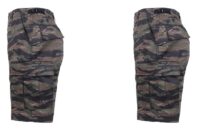Flutes are the spiraled grooves in a cutting tool that contact the workpiece and produce and evacuate chips. Basically, they are the part of the mill or drill that enables it to cut.
End mills for sale – as well as other specialty mills and drills – are available in multiple flute counts and variations. Two and four-flute mills are common, but there are higher flute count mills, too.
So, what are the considerations you need to take with flute count?
Flute Count Implication
Flute count has a marked impact on tool performance with respect to cutting ability, tool strength, and chip evacuation.
One important aspect of the cutting tool impacted by flute count is core size, which is the diameter of the cutting tool tangent to the flutes but at the deepest point.
The more flutes a tool has, the greater the core diameter, and therefore, the stronger the tool – all else being equal, of course.
A higher number of flutes also generally results in a cutting tool with a smaller cutting depth, which for the operator means that a higher flute count usually corresponds to a better surface finish on the workpiece.
However, too many flutes can adversely impact chip removal, as larger valleys (the spaces between the flutes) correspond to higher chip evacuation. This makes cutting tools with higher flute counts better for cutting harder materials that require greater core strength, and which will produce more, smaller chips that are easier to evacuate.
Flute Count and Application
Another way to approach the quandary of flute count is by application. For instance, lower flute counts are sometimes used for roughing work where a relatively large volume of material will be removed and speed and chip evacuation are paramount.
The flipside is that tools with higher flute counts are often used for finishing applications, in which a comparatively smaller volume of material will be removed, but in which instance a smoother surface finish is desired.
Machining softer materials like aluminum generally calls for a lower flute count as tool core strength is not in sharp focus, and the lower flute count allows the softer, larger aluminum swarf to be more easily evacuated.
Conversely machining harder materials (like ferrous metals) often calls for cutting tools with a higher flute count, with a higher core strength that is necessary to withstand the abuses of machining.
It is also important to keep balance in mind: a common misconception is “more flutes, more feed.” Since higher flute counts hinder chip evacuation, sometimes a tool with a lower flute count is better for higher feed rates.
Where Can You Find Quality, Solid Carbide End Mills for Sale?
Looking for high performance carbide end mills for sale that are made in the United States? Visit OnlineCarbide.com and check out their collection of end mills, chamfer mills, spot drills, and other cutting tools. They even carry variable pitch end mills which can help reduce machine chatter.
Their prices are great and quality is top-notch – and some orders even quality for free shipping.












